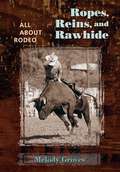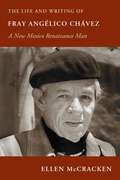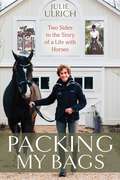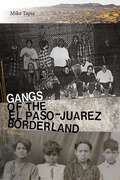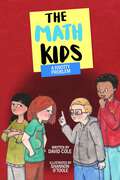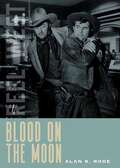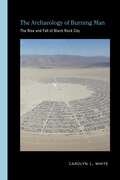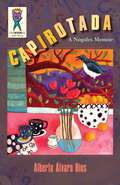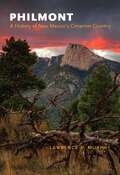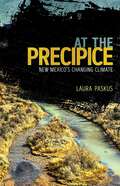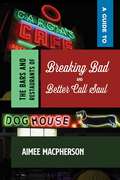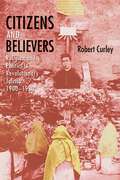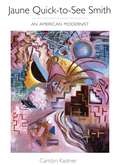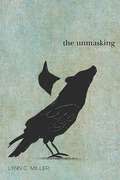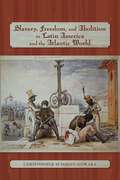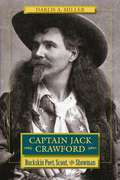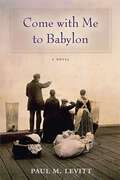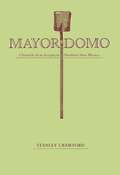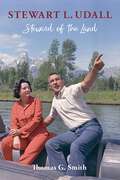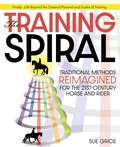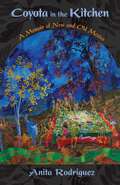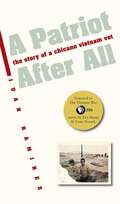- Table View
- List View
Ropes, Reins, and Rawhide: All About Rodeo
by Melody GrovesHeart pounding, blood pumping, the cowboy nods, chute gate opens, and his world begins. Eight seconds of adrenaline rush. Eight seconds of gripping, pulling, and holding on. The animal under him bucks and twists attempting to dislodge the cowboy's seat but the rider sticks like glue. The buzzer sounds, the cowboy dismounts, tips his hat to a cheering crowd, and nods at his proud fellow riders. Just another day at the office.--from Ropes, Reins, and RawhideMelody Groves, a native New Mexican and former bull rider, examines the sport of rodeo, from a brief history of the ranch-based competition to the rodeos of today and what each event demands. One of the first topics she addresses is the treatment of the animals. As she points out, without the bulls or horses, there wouldn't be a rodeo. For that reason, the stock contractors, chute workers, cowboys, and all the arena workers respect the animals and take precautions against their injuries.Groves writes for the rodeo novice, explaining the workings and workers (stock handlers, veterinarians, clowns, pick up men, event judges, etc.) seen in the arena and behind the scenes. She then describes the rodeo events: bull riding, saddle bronc riding, bareback riding, steer wrestling, team roping, tie-down roping, and barrel racing. Interviews with rodeo legends in every event round out the feel for this breathtaking sport. Over ninety photos depict what is described in the text to more fully explain the rodeo, with its ropes, reins, and rawhide.
The Life and Writing of Fray Angélico Chávez: A New Mexico Renaissance Man (Pasó Por Aquí Series in the Nuevomexicano Literary Heritage)
by Ellen McCrackenWinner of the Southwest Book Award from the Border Regional Library Association As a teenager, Manuel Chávez (1910-1996) left his native New Mexico for over a decade of study at the St. Francis Seraphic Seminary in Cincinnati, Ohio, and other midwestern institutions. Included in his curriculum was an introduction to literature and the arts that piqued an interest that would follow him the remainder of his life. Upon returning to New Mexico, he was ordained Fray Angélico Chávez and would become one of New Mexico's most important twentieth-century writers. In The Life and Writing of Fray Angélico Chávez, Ellen McCracken provides a literary biography that includes a deep look into the intellectual and cultural contributions of this Renaissance man. McCracken moves chronologically through a substantial body of work that includes fiction, poetry, plays, essays, spiritual tracts, sermons, historical writing, translation, painting, church renovation, and journalism. From the prolific creativity of the years of his first assignment in Peña Blanca to the decades he spent researching Hispano genealogy in New Mexico, McCracken traces Chávez's complex and changing identity as an ethnic American and religious subject who was also an historian, artist, creative writer, and preservationist. The year 2010 will mark the centenary of Fray Angélico Chávez's birth, and this volume will serve as a fitting tribute.
Packing My Bags
by Julie UlrichA book that entertains and teaches by turns, as a renowned horsewoman entwines stories from her remarkable life with horses with the classical lessons she learned along the way.From bareback romps on a Shetland Pony that bit her and dumped her in a water trough, to the top show jumpers she schooled and competed, and the winning &“diamonds in the rough&” she plucked out of obscurity and trained, the trajectory of horsewoman Julie Ulrich&’s life has followed a star-lit path of horses and stables and riding arenas across the globe. Say a name of a classical master or a leading rider of the past century, and the likelihood is high that she has brushed shoulders with, learned from, taught, or trained a horse for that equestrian.And so, it makes good sense that Ulrich should not only wish to share some of her adventures—her wins and losses, successes and hardships—but that she would assemble them in a unique manner that best showcases the two sides of whoshereally is: an incredibly hard worker with a sharp sense of humor; an eager adventurer who also loves teaching, and above all, believes in the value of a life lived for horses.This two-sided approach means that, as readers laugh at her witty asides, they&’ll also glean an authentic understanding of the horsemanship ideals that weave together equestrian sport&’s past with its present. They&’ll learn the names of movers and shakers and players and playmakers within the industry, and they&’ll come to value the relationships that are at the heart of anyone&’s success in the horse world.Between chapters, Ulrich summons the extraordinary teaching talent for which she might be best known and provides practical guidance and instruction on numerous topics, including:Rider balance and position.Training methodology.Half-halts and improving the use of horse&’s hind legs.Shoulder-in.Communication between rider and horse.And more.Using the multiple moves she terms &“new beginnings&” as her guideposts, Ulrich ensures readers understand that starting over and starting again and starting something new aren&’t precipices to avoid but opportunities to grow and change, and with horses, they are usually unavoidable. So you might as well ride forward with gusto.Rich with horse world history and chock full of invaluable wisdom gained over a lifetime of serious study and application, Ulrich&’s &“memoirplus&” is for every person who sat on a horse and thought, &“I want to dothisfor the rest of my life.&”
Gangs of the El Paso–Juárez Borderland: A History
by Mike TapiaThis thought-provoking book examines gang history in the region encompassing West Texas, Southern New Mexico, and Northern Chihuahua, Mexico. Known as the El Paso–Juárez borderland region, the area contains more than three million people spanning 130 miles from east to west. From the badlands—the historically notorious eastern Valle de Juárez—to the Puerto Palomas port of entry at Columbus, New Mexico, this area has become more militarized and politicized than ever before. Mike Tapia examines this region by exploring a century of historical developments through a criminological lens and by studying the diverse subcultures on both sides of the law.Tapia looks extensively at the role of history and geography on criminal subculture formation in the binational urban setting of El Paso–Juárez, demonstrating the region&’s unique context for criminogenic processes. He provides a poignant case study of Homeland Security and the apparent lack of drug-war spillover in communities on the US-Mexico border.
A Knotty Problem: The Math Kids (Book 7) (The Math Kids)
by David ColeTensions rise between the math kids. When Stephanie finds out her soccer team has a tournament on the same day as the district math competition, an upset Justin offers her a choice: choose Math Kids or leave the club. Dismayed by his attitude, Stephanie quits and Catherine goes with her. With their club in shambles, the future of their friendships is further threatened by the news that Justin's dad has been offered a new job and wants to move his family to St. Louis. Jordan, Justin, Catherine, and Stephanie may face the permanent fracture of their friend group and a bleak end to their school year—unless they can come together to overcome some impossible situations. Problem-solving skills apply to much more than homework in the latest addition to the Math Kids series. Great for fans of Hans Magnus Enzenberger's The Math Devil.
Blood on the Moon (Reel West Series)
by Alan K. RodeOf the movies that writers and historians call &“Noir Westerns,&” none is more celebrated than 1948&’s Blood on the Moon. The comingling of the Western genre and the noir style crystalized in this extraordinary film, in turn influencing Westerns in the 1950s to become darker and more psychological. Produced during the height of the post–World War II film noir movement, Blood on the Moon is a classic Western immersed in the film noir netherworld of double crosses, government corruption, shabby barrooms, gun-toting goons, and romantic betrayals. With this volume, biographer and noir expert Alan K. Rode brings the film to life for a new generation of readers and film lovers.
The Archaeology of Burning Man: The Rise and Fall of Black Rock City (Archaeologies of Landscape in the Americas Series)
by Carolyn L. WhiteEach August staff and volunteers begin to construct Black Rock City, a temporary city located in the hostile and haunting Black Rock Desert of northwestern Nevada. Every September nearly seventy thousand people occupy the city for Burning Man, an event that creates the sixth-largest population center in Nevada. By mid-September the infrastructure that supported the community is fully dismantled, and by October the land on which the city lay is scrubbed of evidence of its existence. The Archaeology of Burning Man examines this process of building, occupation, and destruction.For nearly a decade Carolyn L. White has employed archaeological methods to analyze the various aspects of life and community in and around Burning Man and Black Rock City. With a syncretic approach, this work in active-site archaeology provides both a theoretical basis and a practical demonstration of the potential of this new field to reexamine the most fundamental conceptions in the social sciences.
Capirotada: A Nogales Memoir
by Alberto Alvaro RíosCapirotada, Mexican bread pudding, is a mysterious mixture of prunes, peanuts, white bread, raisins, milk, quesadilla cheese, butter, cinnamon and cloves, Old World sugar--all this, writes Alberto Rios, and things people will not tell you.Like its Mexican namesake, this memoir is a rich melange, stirring together Rios's memories of family, neighbors, friends, and secrets from his youth in the two Nogaleses--in Arizona and through the open gate into Mexico. The vignettes in this memoir are not loud or fast. Yet like all of Rios's writing they are singular. Here is the story about a rickety magician, his chicken, and a group of little boys, but who plays a trick on whom? The story about the flying dancers and mortality. About going to the dentist in Mexico because it is cheaper, and maybe dangerous. About a British woman who sets out on a ship for America with the faith her Mexican GI will be waiting for her in Salt Lake City. And about the grown son who looks at his father and understands how he must ovide for his own boy.This book's uncommon offering is how it stops to address the quiet, the overlooked, the every day side of growing up. Capirotada is not about prison, or famous heroes. It is instead about the middle, which is often the most interesting place to find news.Capirotada was selected as the 2009 ONEBOOKAZ by the Arizona State Library, Archives and Public Records.
Philmont: A History of New Mexico's Cimarron Country
by Lawrence R. MurphyHere is the first comprehensive history of the Colfax County area of northeastern New Mexico. Best known today as the home of the Philmont Scout Ranch, where thousands of Boy Scouts from around the world gather every year, this beautiful country has a violent and varied past. Centering around the town of Cimarron, the region includes much of the vast Maxwell Land Grant, one of the largest pieces of land to be owned by one man in the history of the United States. Controversy over control of the land began in the sixteenth century with quarrels among rival American Indian tribes. Spanish and later American troops continued the bloodshed for centuries more. The culmination of the area&’s history of violence was the notorious Colfax County War between homesteaders and landowners that began in 1875 and continued until the Supreme Court acted fifteen years later. A gold and silver rush lured prospectors to the Maxwell ranch and booming Elizabethtown in the 1860s. But by 1870 the supply of precious metals was almost exhausted, and today Elizabethtown is a ghost town.&“An interesting and welltold account of an important area, Philmont deserves a place on the Western book shelf.&”—Denver Post
At the Precipice: New Mexico's Changing Climate
by Laura PaskusAt the Precipice explores the question many of us have asked ourselves: What kind of world are we leaving to our children? The realities of climate change consume the media and keep us up at night worrying about the future. But in New Mexico and the larger Southwest, climate change has been silently wreaking havoc: average temperatures in the Upper Rio Grande Basin are increasing at double the global average, super fires like Las Conchas have devastated mountains, and sections of the Rio Grande are drying up.Laura Paskus has tracked the issues of climate change at both the state and federal levels. She shares the frightening truth, both in terms of what is happening in nature and what is not happening to counteract the mounting crisis. She writes, &“I wonder about the coming world. Which trees will grow, which birds will have survived. . . . The door to that new world has opened. And there&’s no going back.&” And yet our future is not yet determined—or is it?
A Guide to the Bars and Restaurants of Breaking Bad and Better Call Saul
by Aimee MacphersonA toast to curly fries, hot dogs, and hard-shell tacos, Aimee Macpherson’s guide to the bars and restaurants of Breaking Bad and Better Call Saul celebrates the critically acclaimed shows’ fusion of Albuquerque’s real and imagined food and drink.The restaurants and bars featured in Macpherson’s compendium show us glimpses of Walter White’s and Jimmy McGill’s Albuquerque. From the Dog House to Savoy Bar and Grill, from Tuco’s Hideout to Los Pollos Hermanos and every pit stop in between, Macpherson takes us on a tour of the Duke City’s dreamscape of edible artifacts, connecting us to the on-screen heroes and villains we love and admire. Show by show, season by season, Macpherson reveals how restaurants and bars undergo hours of painstaking transformations before appearing on the small screen. Colorful photography and descriptions of the food and drink accompany Macpherson’s insider show analysis. While this book can’t give you the taste of Mike’s pimento cheese sandwich, it does deliver a flavor of the city that has been a main character in this successful franchise from the time Walter White first broke bad in 2008.So, leave the fancy restaurants to New York, ignore the juicing in LA, forget your Paleo diet, and come and taste Albuquerque. Savor the luscious fare of these small-screen giants as you take in the hot sun, the high altitude, and the Duke City’s local grub.
Citizens and Believers: Religion and Politics in Revolutionary Jalisco, 1900–1930
by Robert CurleyThis book shows the centrality of religion to the making of the 1910 Mexican revolution. It goes beyond conventional studies of church-state conflict to focus on Catholics as political subjects whose religious identity became a fundamental aspect of citizenship during the first three decades of the twentieth century.
Jaune Quick-to-See Smith: An American Modernist
by Carolyn KastnerThe first full-length critical analysis of the paintings of Jaune Quick-to-See Smith, this book focuses on Smith&’s role as a modernist in addition to her status as a wellknown Native American artist. With close readings of Smith&’s work, Carolyn Kastner shows how Smith simultaneously contributes to and critiques American art and its history.Smith has distinguished herself as a modernist both in her pursuit of abstraction and her expressive technique, but too often her identity as a Native American artist has overshadowed these aspects of her work. Addressing specific themes in Smith&’s career, Kastner situates Smith within specific historical and cultural moments of American art, comparing her work to the abstractions of Kandinsky and Miró, as well as to the pop art of Rauschenberg and Johns. She discusses Smith&’s appropriation of pop culture icons like the Barbie doll, reimagined by the artist as Barbie Plenty Horses. As Kastner considers how Smith constructs each new series of artworks within the artistic, social, and political discourse of its time, she defines her contribution to American modernism and its history. Discussing the ways in which Smith draws upon her cultural heritage—both Native and non-Native—Kastner demonstrates how Smith has expanded the definitions of &“American&” and &“modernist&” art.
The Unmasking: A Novel
by Lynn C. MillerBest friends Bettina, Miriam, and Fiona are shocked when their dean of liberal studies dies in a single-car accident amid accusations of mishandling university funds. They suspect murder, especially after learning that the dean&’s estranged wife will inherit three million dollars. Events take a surprising turn when they travel from Austin, Texas, to a Chautauqua performance in Silver City, New Mexico, where they join several others, some with questionable motives, including the dean&’s wife and her lover. In the close confines of the lodge, the group brings to life remarkable women from history—including Victoria Woodhull, Gertrude Stein, Edith Wharton, Mabel Dodge Luhan, and Virginia Woolf. But when one woman is kidnapped and another disappears, the friends&’ lives are forever changed as they realize that the masks we wear often hide chilling truths.
Slavery, Freedom, and Abolition in Latin America and the Atlantic World (Diálogos Series)
by Christopher Schmidt-NowaraThe last New World countries to abolish slavery were Cuba and Brazil, more than twenty years after slave emancipation in the United States. Why slavery was so resilient and how people in Latin America fought against it are the subjects of this compelling study. Beginning with the roots of African slavery in the fifteenth- and sixteenth-century Iberian empires, this work explores central issues, including the transatlantic slave trade, labor, Afro-Latin American cultures, racial identities in colonial slave societies, and the spread of antislavery ideas and social movements. A study of Latin America, this work, with its Atlantic-world framework, will also appeal to students of slavery and abolition in other Atlantic empires and nation-states in the early modern and modern eras.
Captain Jack Crawford: Buckskin Poet, Scout, and Showman
by Darlis A. MillerJack Crawford (1847–1917) entertained a generation of Americans and introduced them to their frontier heritage. A master storyteller who presented the West as he experienced it, he was one of America&’s most popular performers in the late nineteenth century.Dressed in buckskin with a wide-brimmed sombrero covering his flowing locks, Crawford delivered a &“frontier monologue and medley&” that, as one New York City journalist reported, &“held his audience spell-bound for two hours by a simple narration of his life.&”In this biography, Darlis Miller re-creates his experiences as a scout, rancher, miner, reformer, husband and father, and poet and entertainer to reinterpret the American Dream and the lure of getting rich pursued by many during the Gilded Age.
Come with Me to Babylon
by Paul M. LevittIn 1910 the Cohen family, in search of the Golden Medina, undertakes a dangerous journey from Russia to the United States, where the new world exposes family secrets, cultural conflicts, the corruption of the American Dream, and love's divides. Traveling in steerage to Ellis Island, the family endures the poverty and dirt of New York City and retreats to a farm in southern New Jersey--to find not the agricultural Eden they were promised, but Babylon. Told in several voices, this tale bears witness to a new generation learning to find hope in a land that often sacrifices human decency for profit and greed.
Mayordomo: Chronicle of an Acequia in Northern New Mexico
by Stanley CrawfordIrrigation ditches are the lifelines of agriculture and daily life in rural New Mexico. This award-winning account of the author's experience as a mayordomo, or ditch boss, is the first record of the life of an acequia by a community participant.
Stewart L. Udall: Steward of the Land
by Thomas G. SmithAs a three-term member of Congress and as the secretary of the interior in the Kennedy and Johnson cabinets (1961–1969), Stewart L. Udall (1920–2010) was a distinguished public servant and one of the great environmental leaders in US history. This book, the first biography of Udall, introduces his work to a new generation of Americans concerned with the environment. The author traces the influences on Udall&’s career, the evolution of his views on conservation, and his setbacks as well as his triumphs.In addition to his efforts to preserve wilderness areas and protect the planet, Udall advocated reforming the seniority system in Congress, limiting the production and testing of nuclear weapons, promoting coexistence with the Soviet Union, and helping oppressed peoples in emerging nations. A visionary leader, Udall was inspired by his pioneering Mormon forebears who helped settle the Arizona high plateau, where he first connected with the natural world.
Sweeney
by Robert JulyanThe fictional High Plains village of Sweeney, New Mexico, population 856 and falling, is like so many small towns in rural America--once vibrant and alive but now a dry husk of obsolescence, decay, and despair. Only its few remaining citizens care that it not die like so many other towns, but when a handful of them concoct a plot to draw attention to their hometown, the result is a hilarious romp through the oddities and opportunities of small town life. Aliens, nudists, naked bull riders, Druids, phony Indians, and real Indians--all play a role in Sweeney's quixotic journey of survival and self-discovery.
Training Spiral
by Sue GriceEngaging new ways to understand and implement time-proven systems of horse training. The &“Scales of Training,&” &“Training Scale,&” and &“Training Pyramid&” are familiar terms to riders. Around the globe and across disciplines, equestrians hear reference to them or study them as a part of their equestrian education. Dressage rider and trainer Sue Grice grew up with these concepts, too, and like many, found them to be not only fairly boring, but also confusing when it came to actually implementing them as part of daily training. In the course of her work with other riders, she came to realize that although many seemed to know about the Scales of Training in theory, few actually applied them in practice. Grice determined that this was because there was really no clear framework or methodology for implementing the system in a progressive manner. So Grice conceived a new approach based on the standard but with a focus on a better rate of success. Success could be achieved when the rider was engaged with the system and understood how to continually adhere to it, even as advances (or falters) might occur. For over 30 years she has continued to develop and apply her ideas, and now she has finally brought them together to share with the world in this book. Here readers find a detailed plan for applying what Grice calls the &“Training Spiral.&” She does not try to rewrite what history has shown to work in the development of the riding horse, but instead simply provides a fresh framework that enables riders and trainers to: Apply the classical elements of the Training Scale in a more progressive and logical manner, and, Employ them systematically within daily training as well as over a longer period of time. Grice provides clear explanations of how to use each of the six elements (Rhythm, Suppleness, Contact, Impulsion, Straightness, and Collection), how the elements are to be used in order, and what can go wrong if they are applied in the wrong order. Clear examples are given at all levels of training, and detailed case studies demonstrate how the Training Spiral can succeed where traditional systems have failed. The spiral structure provides a means of applying the Scales of Training in practice that is not just logical but also extremely easy to follow. The clarity of Grice's approach also helps horses understand what is being asked of them, leading to a happier relationship between horses and riders, and training that progresses more quickly and easily overall. The Training Spiral is an invaluable and immensely practical guide for trainers and riders at all levels, from novice to advanced.
Living Well with Dr. Michelle: A Comprehensive Handbook for Optimal Health and Unlimited Energy
by Dr. Michelle C. JorgensenFar too many of us have no idea how our bodies really work. The good news? This comprehensive guide provides a regenerative, energy-boosting approach to wellness that will empower you to live the life you want.Holistic dentist and wellness provider Dr. Michelle Jorgensen has seen patient after patient come to her overwhelmed by a deluge of options, misinformation, and conflicting opinions. In today&’s sea of often confusing advice on how to make healthy choices, it can be challenging to weed out the valuable tips from all the rest. She&’s here to change that. With more than 30 recipes, from healthy smoothies to slow cooker staples, Living Well with Dr. Michelle simplifies the quest for better health based on the best practices from time-tested natural wisdom and evidence-based modern science to: Promote total body wellness starting with the tiny, living building blocks that make up your body Tap into nature&’s five elements—fire, earth, plants, water, and air—for better health in everyday life Harness the power of electrons to deliver the energy your body needs to repair and recharge Jumpstart your journey to better health by knowing what questions to ask and taking an active role in your wellness Packed with self-assessment tools and other resources to help you enact these principles in your own life, Living Well with Dr. Michelle will ensure that you can not only stay healthy, but learn to live well.
Coyota in the Kitchen: A Memoir of New and Old Mexico (Querencias Series)
by Anita RodríguezThis book of stories and recipes introduces two eccentric families that would never have eaten together, let alone exchanged recipes, but for the improbable marriage of the author&’s parents: a nuevomexicano from Taos and a painter who came from Texas to New Mexico to study art. Recalling the good and the terrible cooks in her family, Anita Rodríguez also shares the complications of navigating a safe path among contradictory cultural perspectives. She takes us from the mountain villages of New Mexico in the 1940s to sipping mint juleps on the porch of a mansion in the South, and also on a prolonged pilgrimage to Mexico and back again to New Mexico. Accompanied by Rodríguez&’s vibrant paintings—including scenes of people eating on fiesta nights and plastering an adobe church—Coyota in the Kitchen shows how food reflects the complicated family histories that shape our lives.
The Arranged Marriage: Poems (Mary Burritt Christiansen Poetry Series)
by Jehanne DubrowWith her characteristic music and precision, Dubrow&’s prose poems delve unflinchingly into a mother&’s story of trauma and captivity. The poet proves that truth telling and vision can give meaning to the gravest situations, allowing women to create a future on their own terms.
A Patriot After All: The Story of a Chicano Vietnam Vet
by Juan RamirezJuan Ramirez always believed he would die in Vietnam. As a teenager growing up in the San Francisco area in the early 1960s, Nam was there, just over the horizon, like the distant thump of artillery. His father and uncles had served in World War II, another uncle in Korea. Numerous cousins had enlisted. At nineteen, Ramirez decided to embrace the war. In 1968, the year of the Tet offensive, Ramirez joined the U.S. marines.Two bloody tours later, Ramirez survived, but at immense cost. Twice wounded, undesirably discharged, and plagued by survivor's guilt, Ramirez surveys the toll of Vietnam on flesh and spirit in this captivating memoir.Ramirez tells his story in a voice not often heard from the war, that of a Chicano soldier. By tracing his roots, and exploring the cultural pressures and social demons that weighed on his family and community, Ramirez offers an unflinching look at the fall and redemption of one Mexican American veteran.Ramirez has given us a rather unique and clear-eyed view inside the life and times and thoughts of a young Chicano who joins the marines and goes to Vietnam to find his destiny. . . . Fascinating reading.--Joseph L. Galloway, author of We Were Soldiers Once . . . And Young.
